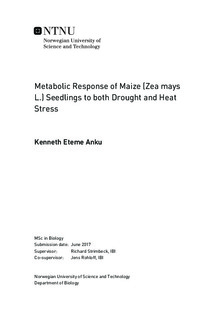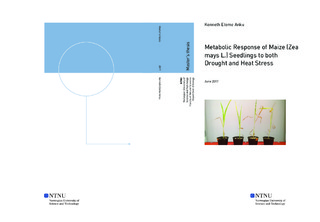| dc.description.abstract | The development of resistant maize (Zea mays) varieties against drought and heat is on the rise as these abiotic stress factors affect maize production. Plants including maize respond by altering their metabolism to produce LEA proteins (dehydrins), antioxidants, compatible solutes and some secondary metabolites as strategies to maintain plant metabolism. This study looks at identifying dehydrins and metabolites in maize leaves subjected to both drought and heat stress.
Two genotypes namely; Obaatampa a tropical variety and Sun Sweet, a temperate variety were subjected to drought, heat, combined stress (heat x drought) and a control condition over a period of 7 days in a 2x2 factorial design. From the same plant, samples were taken for metabolite profiling and protein extraction. GC-MS metabolite profiling detected 312 metabolites including amino acids and oligopeptides, carbohydrates, organic acids and terpenoids among others. Aconitic acid and asparagine were up regulated in all 3 conditions. Proline was also up regulated under heat and combined stress condition but drought observed a low regulation of proline. Drought generally observed a low regulation of metabolites; however, maleic acid was up-regulated under drought stress. Raffinose among other carbohydrates was up regulated under all conditions implying a possible osmotic function. Some terpenoids (B-amyrin) were also up regulated implying some defensive mechanisms are being employed against pathogens.
ANOVA-PCA and heatmap gave clear indications of the effect of heat on metabolite regulation. ANOVA-PCA and the heatmap showed that temperature stress regulated majority of these metabolites followed by combined stress then drought as this was evident from the fold-change values. PCA and Anova (Appendix 3) for metabolites show that there was significant (P<0.05) difference between specific metabolites for the two (2) genotypes (ANOVA- Appendix 3). However, the two genotypes reacted in a similar way though they observed some difference with specific metabolites. Furthermore, some dehydrins (DHNs) were also identified in the protein extraction. These identified proteins include 20, 23, 50 and 100 kDa weight dehydrin. These DHNs were identified in all stress conditions and in all genotypes. However, problems with proteins extraction prevented a complete picture of dehydrin responses to stress, though plants express unique proteins in all variety of stress conditions. In conclusion, heat stress has a high metabolite effect on plants than drought and combined stress. Furthermore, genotypes respond in a similar way to different stress conditions and produce DHNs, as a tolerance mechanism against stress conditions. | |

